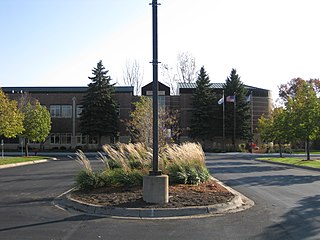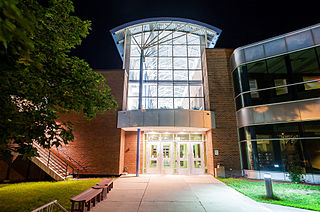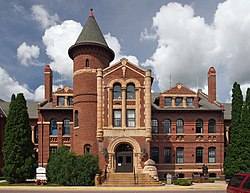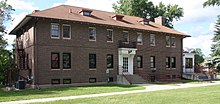
Steele County is a county in the U.S. state of Minnesota. As of the 2020 census, the population was 37,406. Its county seat is Owatonna.

Owatonna is a city and the county seat of Steele County, Minnesota, United States. The population was 26,420 at the 2020 census. Owatonna is home to the Steele County Fairgrounds, which hosts the Steele County Free Fair in August.

Cottage Grove is a city 10 miles (16 km) south of Saint Paul in Washington County in the State of Minnesota. It lies on the north bank of the Mississippi River, north of the confluence with the St. Croix River. Cottage Grove and nearby suburbs form the southeast portion of Minneapolis-Saint Paul, the 16th-largest metropolitan area in the United States, with about 3.69 million residents. Its population was 38,839 at the 2020 census.

Woodbury is a city in Washington County, Minnesota, United States, eight miles east of Saint Paul along Interstate 94. It is part of the Minneapolis–Saint Paul metropolitan area. The population was 75,102 at the 2020 census, making it Minnesota's eighth most populous city.

Winona is a city in and the county seat of Winona County, Minnesota, United States. Located in bluff country on the Mississippi River, its most noticeable physical landmark is Sugar Loaf. The population was 25,948 at the 2020 census.

Minnesota State University, Mankato is a public university in Mankato, Minnesota, United States. It is Minnesota's second-largest university and has over 145,000 living alumni worldwide. Founded in 1868, it is the second-oldest member of the Minnesota State Colleges and Universities system and is commonly referred to as the flagship institution. It was established as the Second State Normal School in 1858 and officially opened as Mankato Normal School a decade later. Minnesota State University, Mankato is a significant contributor to the local and state economies, adding $827 million annually.

Riverland Community College is a public community college with three campuses in southeastern Minnesota: Albert Lea, Austin, and Owatonna. Founded in 1940, Riverland offers educational programs and courses to over 4,900 students annually through traditional, hybrid, and online delivery systems.

The Lyman School for Boys was established by the Commonwealth of Massachusetts in c. 1884 and operated until c. 1971. The institution opened following the closure of the State Reform School for Boys in Westborough. The school was named for its principal benefactor, philanthropist Theodore Lyman, who served as mayor of Boston, Massachusetts from 1834 to 1836. The property is listed in the National Register of Historic Places.
Administration Building may refer to:

Nudgee is a north-eastern suburb in the City of Brisbane, Queensland, Australia. In the 2021 census, Nudgee had a population of 4,377 people.

Glen Lake Sanatorium, a tuberculosis treatment center serving Hennepin County in Minnesota, opened on January 4, 1916, with a capacity of 50 patients, and closed in 1976. In 1909, the Minnesota State Legislature had passed a bill authorizing the appointment of county sanatorium boards and appropriating money for the construction of county sanatoriums. Glen Lake Sanatorium was the fifth of fourteen county sanatoria that opened in Minnesota between 1912 and 1918. Glen Lake was the first U.S. tuberculosis sanatorium to be accredited by the American Medical Association.The sanatorium had its own post office, and the mailing address was Glen Lake Sanatorium, Oak Terrace, Minnesota, until the surrounding area was incorporated into the City of Minnetonka.

The Minnesota Correctional Facility – Faribault is a state prison located in Faribault, Minnesota. As of March 2023, it had an adult inmate population of about 2,000 men, making it the largest prison in Minnesota by population.

This is a list of the National Register of Historic Places listings in Steele County, Minnesota. It is intended to be a complete list of the properties and districts on the National Register of Historic Places in Steele County, Minnesota, United States. The locations of National Register properties and districts for which the latitude and longitude coordinates are included below, may be seen in an online map.
Porter-Leath, formerly known as the Children's Bureau, is a non-profit organization based in Memphis, Tennessee that serves children and families in the area. Porter-Leath was founded in 1850 as an orphanage and has since grown to six program service areas. The agency retains the early nature of its mission by providing foster care and has also expanded to early childhood education.

The Mount Pleasant Indian Industrial Boarding School in Mt. Pleasant, Michigan, was established by an act of the United States Congress in 1891. This provided funding for creation of an education system of off-reservation boarding schools and vocational training centers to educate Native American children. It was extending a model developed and practiced first at the Carlisle Indian Industrial School, which opened in 1879 and was directed by Richard Henry Pratt, an Army officer.
Owatonna High School (OHS) is a public school in Owatonna, Minnesota, United States. The school was established in 1877. Construction of the current building started in 2021 and finished in 2023 and opened for students fall 2023. It currently has an average of 1600 students and 203 faculty members.
Warren Barnes Dunnell (1851-1931) was an American architect who primarily worked on buildings in Minnesota. Dunnell was born in 1851 in Norway, Maine. His parents moved to Minnesota in 1863 settling first in Winona and later moving to Owatonna. Dunnell attended the University of Minnesota in 1869 but later transferred to the Massachusetts Institute of Technology. He also studied at the École des Beaux-Arts in Paris.

The Owatonna Firemen's Hall, formerly the Owatonna City and Firemen's Hall, is a historic government building in Owatonna, Minnesota, United States. It was built from 1906 to 1907 to house the Owatonna Fire Department and city government offices. The city offices were relocated to the former campus of the Minnesota State Public School for Dependent and Neglected Children in 1974. The Firemen's Hall continues to serve as the headquarters for the Owatonna Fire Department.

The State Home and School for Dependent and Neglected Children was a state institution for children in Providence, Rhode Island. Following the American Civil War, states assumed new responsibilities for the care of adults and children living in poverty or with serious illnesses. The State Home, and organizations like it across the country, sought to remove dependent children from adult correctional institutes, almshouses, and juvenile reformatories. It was located on a cottage-plan campus in what was originally rural western Providence, on a former gentleman's farm. The school was established in 1884 and operated until 1979, when its remaining functions were taken over by other state organizations. Most of its surviving grounds and buildings are now on the Rhode Island College East Campus, and have been listed as a historic district on the National Register of Historic Places.

The Nebraska home for dependent children was an American charitable organization situated at the corner of Eleventh and South streets, in Lincoln, Nebraska. This Home was duly incorporated in 1876. So many came for protection that in 1881, the legislature made an appropriation of US$5,000 for the erection of a permanent building. For some years there after the board of managers and the state shared responsibility and authority for this Home, the state making appropriations from time to time for improvements and maintenance. Later, the state obtained control by refusing to make appropriation unless given complete authority. A further restriction upon appropriations for this institution made the Home available only for children who were subject to adoption. In 1897, it was placed under the immediate control of the state and in 1914, it was placed under the board of control of state institutions.

























